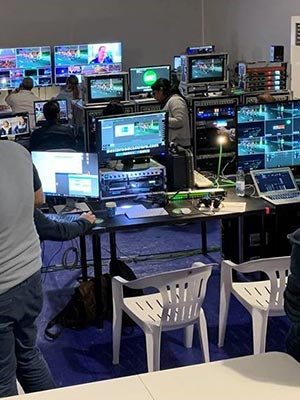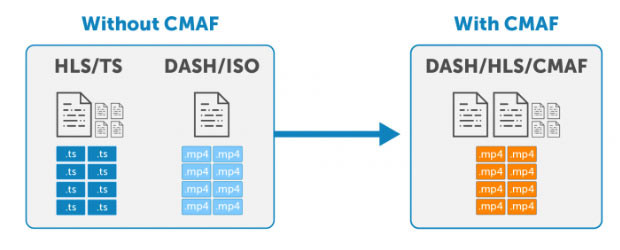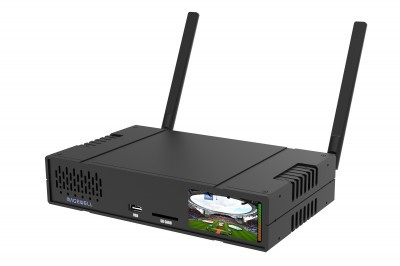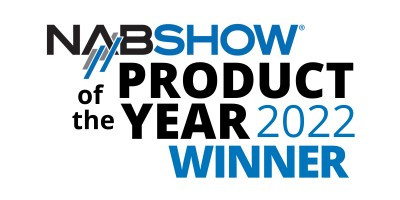In today’s fast paced environment broadcasters need to quickly, easily, and simultaneously share high-quality live content with multiple affiliates or other broadcast facilities. However, today it’s typical for each third-party transmitter to be connected to its own receiver with its own platform and management system. This results in major TV channels having several web interfaces and/or screens to receive and distribute feeds coming in from third-party devices.
In the past, broadcasters set up dedicated links between multiple premises in order to share live video feeds with affiliates. But this process wasn’t ideal, as dedicated links are expensive to set up and require IT experts. Today, video professionals are increasingly using the internet to distribute live video streams as opposed to dedicated links, because the internet is more scalable and low cost. But they need a way to interconnect several third-party live transmission tools. Having multiple screens to look at is complex, inefficient, and costly. By streamlining their production workflow and optimizing costs, broadcasters can offer an increased amount of live video content and boost viewer engagement. This article will identify the key capabilities to look for in a video receiver platform in order to simplify distribution of live feeds to affiliates.
What to look for in a live video reception platform
Deploying a scalable and tailored live video solution that manages and shares all live streams coming in from all transmitters via a single interface is important. Using one screen, broadcasters and video professionals can interconnect to numerous third-party live transmission tools at one time, saving time and money.
Knowing that broadcasters are often on the go and working from remote locations, it’s advantageous to have a receiver device that offers a web-based user interface with a video thumbnail view. This tool allows video professionals to build live video multi-view composed with all input streams, which can be fed to affiliates. The multi-view can be enriched with overlay information for each source, such as audio level and transmitter name. The main advantage of this feature is to reduce data while feeding affiliates with multiple streams, allowing affiliates to choose a main stream from among those.
Through an intuitive web user interface, broadcasters can easily control and oversee a fleet of remote devices, optimize and monitor the video transmissions, all through a single tool.
A key requirement that broadcasters should look for in a live video reception solution is the ability to maintain high-quality streams while offering low latency. During a live event, broadcasters need to ensure there is no delay. Viewers do not want to miss a second of the action, especially for live sports. Choosing a video system with state-of-the-art encoding (i.e., HEVC and next-generation codecs) will ensure high quality video at minimum bitrates, with low latency of only a few seconds. The receiver reliably combines multiple algorithms, such as FEC, ARQ, and VBR rate control, to reduce de-jitter buffering and provide a high quality of service.
Another challenge with delivering live video over the internet or IP is accounting for lost packets. Reliability is critical, especially for live video distribution. The video reception device has to ensure that broadcasters can stream live videos seamlessly and store and forward recorded content — even during unpredictable and unmanageable network conditions. This can be achieved by using the latest contribution technology that incorporates IP bonding techniques, precision timing over bonded cellular and the public internet, and adaptive bitrate encoding, enabling broadcasters to save dropped packets during live transmission due to multiple layers of redundancy. With this type of state-of-the-art technology, broadcasters can automatically recover dropped packets through forward error correction. Then, if the errors are too long or too deep, then automatic retransmission kicks in to request the missing packets.
Video professionals are often using a variety of different types of transmitters in the field. Therefore, it’s also essential to choose a system that is totally agnostic and universal in receiving transmissions from various types of transmitters.
With the video receiver system broadcasters will want the ability to manage multiple streams and distribute to multiple affiliates from a single point of control. This reduces the cost of live content distribution as there is less equipment required. The system should support a variety of streaming protocols, including RTMP, RTSP/RTP, HLS and TS/IP to ensure that broadcasters can freely distribute video content over the public internet and virtually any IP networks, including 3G, 4G and 5G. This is critical, as 5G infrastructures are being built up with major network deployments expected in 2020. 5G technology will help broadcasters and video professionals address the growing consumer demand for high-resolution content, including 4K live sports, on mobile devices like smartphones and tablets.
Finally, broadcasters today are looking for ways to increase operational efficiencies, maximize flexibility, and reduce costs. The cloud has emerged as a technology that can help them achieve all of those goals. Having a receiver system that can be deployed on-premises or operated as a cloud-based service tailored to any news or live video production organization’s workflow and operational constraint is ideal in today’s ever-evolving multiscreen video delivery world.

































